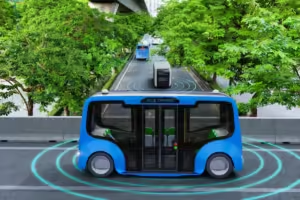Introduction:
Autonomous vehicles, once a futuristic concept, are now a reality shaping the future of transportation. These vehicles, equipped with advanced artificial intelligence (AI) systems, have the potential to revolutionize the way we travel, offering benefits such as increased safety, efficiency, and accessibility. However, as autonomous vehicles become more prevalent on our roads, it is imperative to address the ethical implications associated with their operation.
AI ethics in autonomous vehicles revolves around the fundamental question of balancing safety with decision-making. On one hand, ensuring the safety of passengers, pedestrians, and other road users is paramount. On the other hand, autonomous vehicles must make complex decisions in real time, often in ethically challenging scenarios where trade-offs between different values and priorities are inevitable.
This delicate balance between safety and decision-making requires careful consideration of various factors, including technological capabilities, regulatory frameworks, societal values, and ethical principles. As such, navigating the ethical landscape of autonomous vehicles is not only a technical challenge but also a moral and philosophical endeavor.
In this discussion, we will delve into the multifaceted nature of AI ethics in autonomous vehicles, examining the challenges, dilemmas, and approaches involved in striking a harmonious balance between safety and decision-making. From the design of decision-making algorithms to the resolution of real-world ethical dilemmas, we will explore the complex interplay of technology, ethics, and society in the era of autonomous driving.
Safety in Autonomous Vehicles:
Safety is a paramount concern in the development and deployment of autonomous vehicles. While proponents of this technology often highlight its potential to reduce accidents and save lives through improved driving precision and avoidance of human error, ensuring the safety of autonomous vehicles poses significant challenges.
A. Overview of safety concerns:
- Technical failures: Autonomous vehicles rely on a multitude of sensors, cameras, lidars, and other technologies to perceive their environment and make decisions. Malfunctions or errors in these systems can lead to accidents.
- Cybersecurity risks: As autonomous vehicles become more connected and reliant on software, they become vulnerable to cyberattacks that could compromise their safety and functionality.
- Interaction with human-driven vehicles: Autonomous vehicles must navigate the complex interactions and unpredictability of human drivers, pedestrians, and cyclists, which can introduce new safety risks.
- Legal and liability issues: Determining responsibility and liability in the event of an accident involving an autonomous vehicle raises complex legal and ethical questions.
B. Potential risks and consequences of autonomous vehicle accidents:
- Injuries and fatalities: Despite their potential to reduce accidents, autonomous vehicles are not immune to crashes, which can result in injuries or loss of life.
- Public trust and acceptance: High-profile accidents involving autonomous vehicles can erode public trust and confidence in the technology, hindering its widespread adoption.
- Regulatory scrutiny: Incidents involving autonomous vehicles often trigger regulatory scrutiny and call for stricter oversight, potentially slowing down the development and deployment of these vehicles.
C. Regulatory frameworks and safety standards:
- Government agencies and regulatory bodies around the world are grappling with how to regulate autonomous vehicles to ensure their safety while promoting innovation and development.
- Standards organizations, such as ISO and SAE International, are developing guidelines and standards for the design, testing, and operation of autonomous vehicles to promote safety and interoperability.
- Collaborative efforts between industry stakeholders, policymakers, and safety experts are essential to establish a robust regulatory framework that addresses the unique challenges posed by autonomous vehicles while safeguarding public safety.
In navigating the complex landscape of safety in autonomous vehicles, stakeholders must prioritize rigorous testing, continuous improvement, and collaboration to mitigate risks and ensure the safe integration of this transformative technology into our transportation ecosystem.
Decision-Making Algorithms in Autonomous Vehicles:
One of the defining features of autonomous vehicles is their ability to make real-time decisions based on sensor data and algorithms. These decision-making processes are critical for safely navigating the complex and dynamic environment of the road. However, designing and implementing effective decision-making algorithms in autonomous vehicles present unique challenges and ethical considerations.
A. Types of decision-making algorithms used in autonomous vehicles:
- Rule-based systems: These algorithms rely on predefined rules and logic to govern the behavior of autonomous vehicles in different situations. Rules may be based on traffic laws, safety guidelines, and ethical principles.
- Machine learning algorithms: Machine learning techniques, such as neural networks and reinforcement learning, enable autonomous vehicles to learn from experience and adapt their behavior based on past interactions with the environment.
- Hybrid approaches: Many autonomous vehicles use a combination of rule-based systems and machine learning algorithms to balance safety, efficiency, and adaptability.
B. Factors influencing decision-making in autonomous vehicles:
- Safety considerations: The primary objective of decision-making in autonomous vehicles is to prioritize safety for passengers, pedestrians, and other road users.
- Traffic laws and regulations: Autonomous vehicles must comply with traffic laws and regulations governing speed limits, right-of-way, signaling, and other aspects of driving behavior.
- Ethical principles: Autonomous vehicles may encounter ethical dilemmas where they must make decisions with moral implications, such as prioritizing the safety of occupants versus pedestrians or choosing between different collision scenarios.
C. Ethical considerations in programming decision-making algorithms:
- Transparency and accountability: Autonomous vehicles should be programmed to make decisions transparently and be accountable for their actions, enabling stakeholders to understand and evaluate their behavior.
- Fairness and equity: Decision-making algorithms should strive to treat all road users fairly and impartially, avoiding biases based on factors such as race, gender, or socioeconomic status.
- Human oversight and intervention: While autonomous vehicles operate autonomously, there should be mechanisms in place for human drivers or operators to intervene in critical situations or override automated decisions.
Ethical Dilemmas in Autonomous Vehicles:
As autonomous vehicles navigate the complexities of the road, they inevitably encounter situations where ethical decisions must be made. These ethical dilemmas pose challenges for designers, programmers, policymakers, and society as a whole, as they grapple with balancing competing values and priorities in the context of autonomous driving.
A. Trolley problem and its relevance to autonomous vehicles:
The trolley problem is a classic ethical thought experiment that presents a scenario where a runaway trolley is heading toward multiple people, and the decision-maker must choose whether to divert the trolley onto a different track, potentially sacrificing fewer lives.
In the context of autonomous vehicles, the trolley problem manifests in scenarios where the vehicle must make split-second decisions to avoid collisions, potentially involving trade-offs between the safety of occupants and that of pedestrians or other road users.
B. Conflicting ethical principles in decision-making:
- Autonomy vs. safety: Autonomous vehicles are designed to prioritize safety above all else, but there may be situations where ensuring the safety of occupants conflicts with the safety of others, raising questions about the ethical responsibility of the vehicle.
- Individual vs. collective good: Autonomous vehicles may face dilemmas where prioritizing the safety of individual passengers conflicts with the greater good of society, such as in scenarios where the vehicle must choose between avoiding a collision and protecting vulnerable road users.
C. Cultural and societal differences in ethical preferences:
- Ethical norms and values vary across cultures and societies, leading to differences in how people perceive and prioritize ethical considerations in autonomous driving.
- Cultural factors may influence attitudes towards risk-taking, individualism versus collectivism, and the role of technology in shaping ethical behavior, highlighting the importance of considering cultural diversity in the development and deployment of autonomous vehicles.
Addressing ethical dilemmas in autonomous vehicles requires a nuanced understanding of ethical principles, cultural perspectives, and the dynamics of human-robot interaction. By engaging in transparent and inclusive discussions, stakeholders can work towards consensus-driven solutions that uphold fundamental values such as safety, fairness, and respect for human life in the era of autonomous driving.
Approaches to Balancing Safety and Decision-Making:
The challenge of balancing safety and decision-making in autonomous vehicles requires thoughtful consideration and the implementation of various approaches aimed at mitigating risks while promoting ethical behavior. From algorithmic design to regulatory oversight, stakeholders are exploring diverse strategies to navigate the complex ethical landscape of autonomous driving.
A. Incorporating ethical frameworks into AI algorithms:
- Utilizing ethical principles: Designers and programmers can integrate ethical principles, such as utilitarianism, deontology, and virtue ethics, into the decision-making algorithms of autonomous vehicles to guide their behavior in ethically challenging situations.
- Value alignment: Ensuring that the values and priorities embedded in autonomous vehicle algorithms align with societal norms and preferences can help mitigate ethical conflicts and promote trust and acceptance of the technology.
B. Human oversight and intervention mechanisms:
- Supervisory control: Autonomous vehicles can be equipped with mechanisms that allow human drivers or operators to intervene and override automated decisions in critical situations, providing an additional layer of safety and accountability.
- Ethical review boards: Establishing independent ethical review boards composed of experts from diverse disciplines can help evaluate the ethical implications of autonomous vehicle algorithms and provide guidance on ethical decision-making.
C. Transparency and accountability in AI decision-making:
- Explainable AI: Implementing transparency measures, such as explainable AI techniques, can help users and stakeholders understand how autonomous vehicles make decisions and assess their ethical implications.
- Accountability frameworks: Developing frameworks for assigning responsibility and liability in the event of accidents involving autonomous vehicles can promote accountability among manufacturers, operators, and other stakeholders.
By adopting a multidimensional approach that combines technical innovation, ethical reflection, and regulatory oversight, stakeholders can foster a safe and responsible ecosystem for autonomous driving. While challenges and ethical dilemmas may persist, ongoing collaboration and dialogue are essential for navigating the evolving landscape of AI ethics in autonomous vehicles and ensuring that safety remains a top priority.
Future Directions and Challenges:
As autonomous vehicles continue to evolve and become more integrated into our transportation infrastructure, several future directions and challenges emerge, shaping the trajectory of AI ethics in autonomous driving.
A. Emerging technologies and their impact on AI ethics in autonomous vehicles:
- Advancements in AI: Continued progress in artificial intelligence, including deep learning, reinforcement learning, and natural language processing, will enable more sophisticated decision-making capabilities in autonomous vehicles.
- Connectivity and IoT: The proliferation of connected vehicles and the Internet of Things (IoT) will create opportunities for enhanced communication and collaboration among autonomous vehicles, but also raise concerns about data privacy, cybersecurity, and algorithmic bias.
B. Anticipated challenges in balancing safety and decision-making:
- Ethical complexity: As autonomous vehicles encounter increasingly complex and ambiguous situations on the road, navigating ethical dilemmas will become more challenging, requiring sophisticated algorithms and ethical frameworks.
- Human trust and acceptance: Building public trust and acceptance of autonomous vehicles will remain a significant challenge, particularly in light of high-profile accidents and ethical controversies that may undermine confidence in the technology.
- Regulatory uncertainty: The regulatory landscape governing autonomous vehicles is still evolving, with questions surrounding liability, insurance, data governance, and ethical standards yet to be fully addressed.
C. Opportunities for innovation and improvement:
- Collaborative research: Encouraging interdisciplinary collaboration between researchers, engineers, ethicists, policymakers, and stakeholders can foster innovative solutions to ethical challenges in autonomous driving.
- Ethical design principles: Integrating ethical considerations into the design and development process of autonomous vehicles from the outset can help mitigate risks and promote responsible behavior.
- Public engagement and education: Engaging the public in discussions about AI ethics in autonomous vehicles and raising awareness about the benefits, risks, and trade-offs associated with the technology can foster informed decision-making and societal acceptance.
Conclusion:
The rapid advancement of autonomous vehicles presents a transformative opportunity to revolutionize transportation, improve road safety, and enhance mobility for individuals and communities. However, as we journey towards a future of autonomous driving, it is essential to recognize and address the ethical implications inherent in this technology.
The ethical considerations surrounding AI ethics in autonomous vehicles are multifaceted, ranging from ensuring the safety of passengers and pedestrians to navigating complex ethical dilemmas in decision-making. Balancing safety with ethical decision-making requires a collaborative effort involving researchers, engineers, policymakers, ethicists, and society at large.
While challenges and uncertainties lie ahead, there are reasons for optimism. Through proactive engagement, transparent dialogue, and the integration of ethical principles into the design, development, and deployment of autonomous vehicles, we can foster a future where safety, fairness, and accountability are paramount.
As we continue to navigate the evolving landscape of AI ethics in autonomous driving, let us remain committed to upholding fundamental values and principles that prioritize human well-being, promote equitable access to transportation, and ensure the responsible and ethical use of technology.
In closing, let us embrace the opportunities for innovation and progress while remaining vigilant in our commitment to addressing the ethical challenges and complexities inherent in the journey towards a future of autonomous vehicles. By doing so, we can create a future where autonomous driving enhances the quality of life for all while upholding the highest standards of safety, ethics, and societal values.












